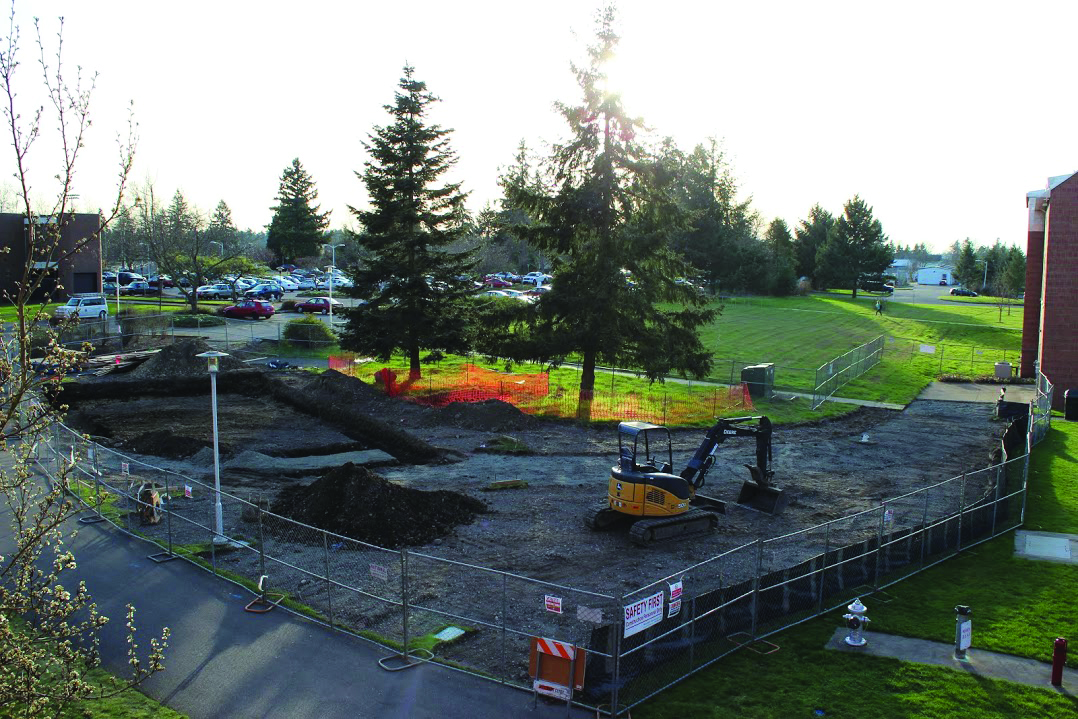
by Samantha Lund, News Editor

View of the construction site from second floor Rieke Science Center. As of March 6, the site is pretty bare. “What may look like dirt and mud now will soon be home to a new plant science research center for faculty and students,” Quigg said.
A new building will be added to campus this summer, just in time to hold the flowers that bloom in spring.
A greenhouse is joining Rieke and Morken on the southwest side of campus. The project will be completed over summer and presented to campus Aug. 5.
Plant biology will be the focus of the building, but other sciences can make good use of it, too.
The state-of-the-art greenhouse will offer students the opportunity to carry out experiments on genetics, cell processes, gene expression and evolutionary adaptations.
There are genetics courses required for biology majors and now those students will be able to use the greenhouse for their experiments.
The building will also be a showcase for a botanical collection to showcase biodiversity.
The greenhouse will be 1,700 square feet and cost approximately $880,000.
The firm AustinCina Architects helped design the building along with PLU.
The new building will use a closed-loop, geothermal energy system, meaning no greenhouse-gas-producing emissions will be used in the heating and cooling systems.
Matt Smith, associate professor of biology and dean of natural sciences is heading the project with help from the Office of Advancement.
Rieke was built with a sunroof-style greenhouse inside, but that was not up to par, Smith said.
The project has been in the works since December 2010 when a consultant came to campus to take a look at the existing structure.
The consultant decided that it was not worth the cost to update the “greenhouse” in Rieke and recommended PLU put its money into a new structure.
The biology department came up with the concept and vision for the structure and met with PLU supporter Carol Sheffels Quigg to get her involved in the project.
“How can you study biology without plants?” Smith said. “We need to be able to showcast how important they are to students.”
The greenhouse will be built with donations from retired faculty members, the Murdock Charitable Trust, the Norcliffe Foundation and individual donors. The Murdock Trust in Vancouver, Wash. and the Northcliffe Foundation in Seattle also donated to the project.
Quigg is the main individual donor responsible for the greenhouse.
“It’s very exciting to know that work has started on the greenhouse site,” Quigg said. “It will be a wonderful, and sorely needed, addition to campus.”
Quigg’s family has strong ties to PLU, even to this day. Plant life and PLU are both very important to Quigg.
“I come from a farm background, and am very mindful of the extreme importance of plants in our lives,” Quigg said. “In short, they are essential to our lives.”
The new greenhouse will be a very welcome asset to the PLU campus, Quigg said.
The biology department in particular will make good use of the greenhouse.
“One of the common sayings in the Division of Natural Sciences is that students learn by doing science,” biology professor Neva Laurie-Berry said. “The new greenhouse will allow students to be engaged in plant biology hands-on in a modern, professional setting.”
All biology majors are required to take a course in plant biology at PLU. The greenhouse will more accurately reflect the current state of the field, Laurie-Berry said.
Laurie-Berry is a biology professor whose research focuses on bacterial pathogens that infect tomato plants. For her, the greenhouse means she can study the infection in a natural tomato host rather than being limited to smaller model plants.
Laurie-Berry said the greenhouse will make an immeasurable difference.
“The biggest problem I faced in my Plant Physiology lab this past fall was a lack of suitable growing space,” Laurie-Berry said. “Most of our experiments failed because the plants could not thrive on lighted shelves in an equipment room.”
The new growing space will provide the proper light, temperature and humidity levels for plant growth.
Current biology students see the addition as a much needed step for their department.
Senior Lucas Sontra took the mandatory botany class and said the addition will make learning much easier for future students.
“Currently, the class has to travel to University of Washington to do [research] and being able to get the same experience on campus without needing to plan a field trip would be very beneficial,” Sontra said. “I think it will also attract students who want to focus on botanical studies to PLU.”
Sontra is excited at the prospect of the new facility opening the doors to new research opportunities, he said.
For Mary Ellard-Ivey, a biology professor, the greenhouse will be an asset to both of her classes.
“The ability to grow large populations of model genetic plants will allow students to do crosses and demonstrate principles of genetics,” Ellard-Ivey said. “I am particularly excited about the opportunity I will soon have to bring some of my work to PLU and involve students.”
For now, the greenhouse is a plot of land sectioned off between Morken and Rieke.
Students should not experience any difference in their day-to-day lives because of the construction.
Next year, students will likely see new classes, new projects and new flowers blooming on campus and in the greenhouse.
UPDATE MAR. 18, 2015: The original version of this post incorrectly identified Matt Smith as professor and dean of students, he is an associate professor of biology and the dean of natural sciences; additionally, PLU does not have genes classes, it has genetics classes.

















